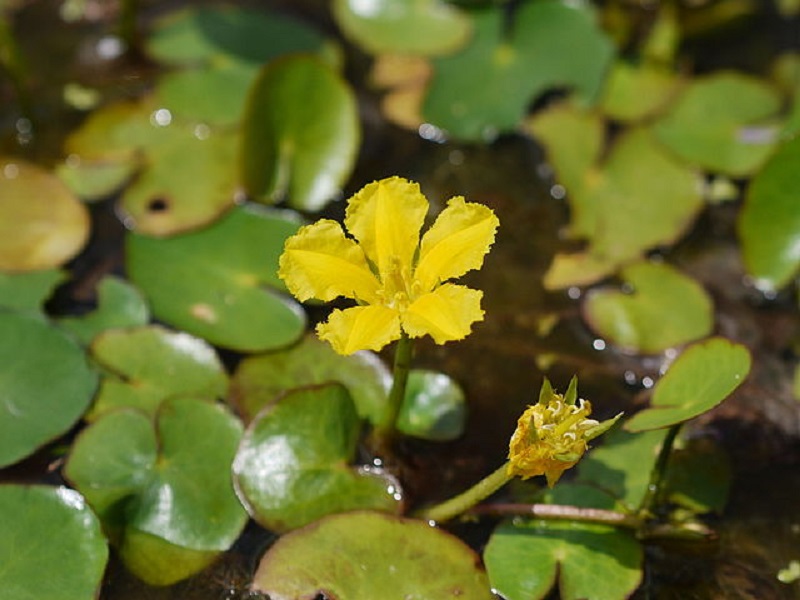22 Best Pond Plants – Discover Popular Aquatic Plants for Ponds
Ponds have been highly popular recently. They appear not only in large gardens, but also in small home yards. Picking good pond plants is essential, as certain species aren't suitable for everyone. Check what to pay attention to when buying them and learn which pond flowers are the most popular. We have prepared a comprehensive guide just for you.

Why are pond plants worth having?
A pond without any plants or with just a few of them doesn’t look as good as it could. That’s why many people decide on many flowers and green plants species which can grow in wetlands and swamps or submerged in water. But note that not all pond plants can be used together in the same place. A lot depends on how big the pond and the surrounding area are.
The variety of plants in a pond is related mostly to their height. Small ponds benefit the most from up to 50 cm tall plants. If the reservoir is larger, you can decide on taller species. Some of them can grow even 2 meters tall.
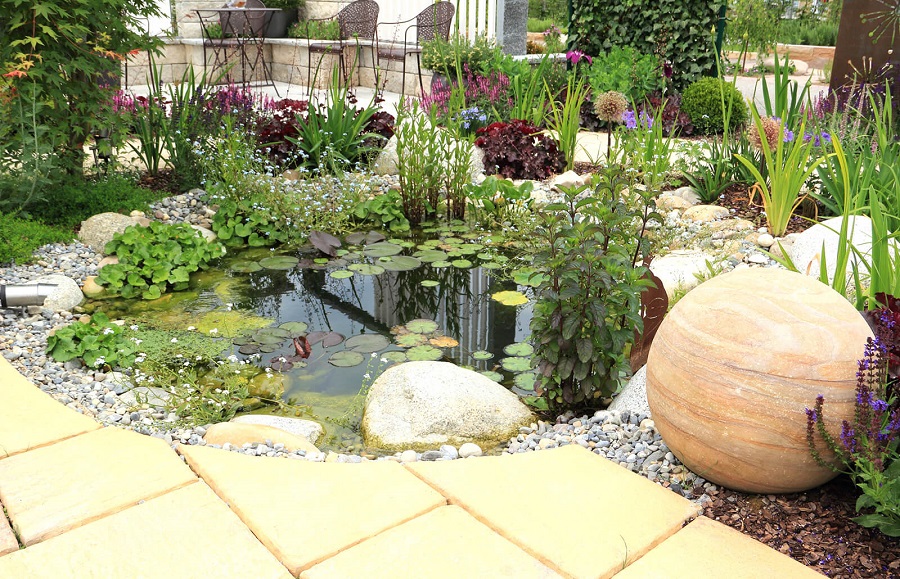
What are the characteristics of pond plants?
Regardless of what plants you pick for your pond, each of them are characterized by the most important feature – a low price. Plants of this type can be purchased for $2-$5. It’s an expense you can surely afford. Plus, sometimes you can gain even more. Some pond plants purify water. Thanks to them, you have to clean the reservoir less frequently. It saves your time and money.
There’s another crucial aspect of pond plants – they require minimal care. Most species don’t need anything special, and they are quite resistant to unfavourable conditions.
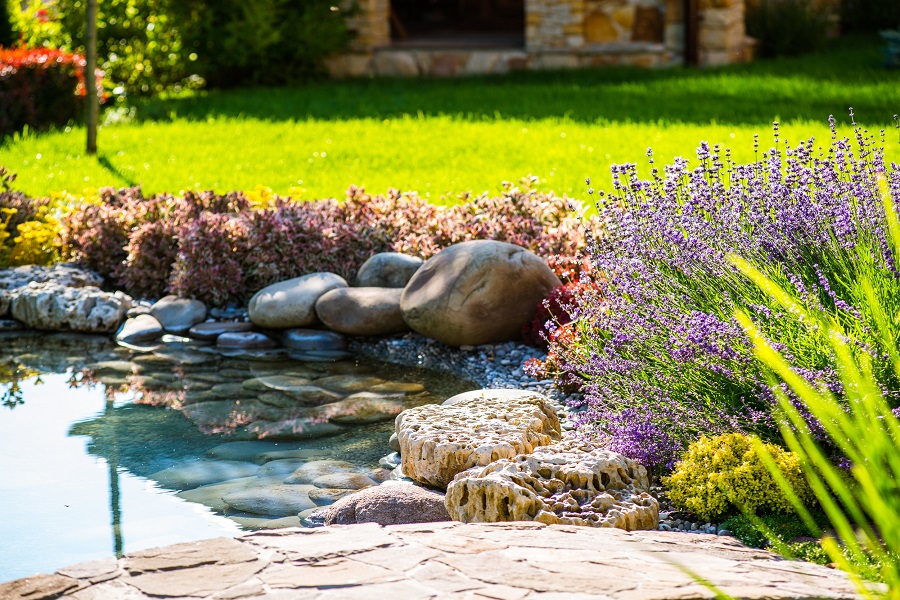
Water-filtering pond plants
Water-filtering pond plants are absolutely essential for any reservoir. But the decision which particular species to pick is not as obvious as it might seem. It’s because different plants can grow in the litoral zone, while open water is suitable for other species.
As for marginal plants, common reed is the most popular choice. Thanks to this plant, excess nitrogen gets removed from the mud – it’s a particle that might reduce durability of other plants. Common reed is easy to maintain and basically doesn’t need any special care. The height is the only disadvantage of this species. If your pond is small, use it in moderation.
Other water-filtering pond plants can be used across the entire surface of the reservoir. Take a look at the most popular species below.
Water hyacinth (Eichhornia crassipes)
Water hyacinth (Eichhornia crassipes), or kochuripana – that’s the name used in some countries – is one of the most popular pond plants. The species comes from Amazonia and is an annual. The peculiar leaves allow the plant to float on the water. It develops beautiful violet flowers.
Water hyacinth loves full sun, so make sure other plants don’t block the sunlight. Although the plant is not very demanding, you can reinforce it with fertilizer. Universal multi-ingredient products are the best option.
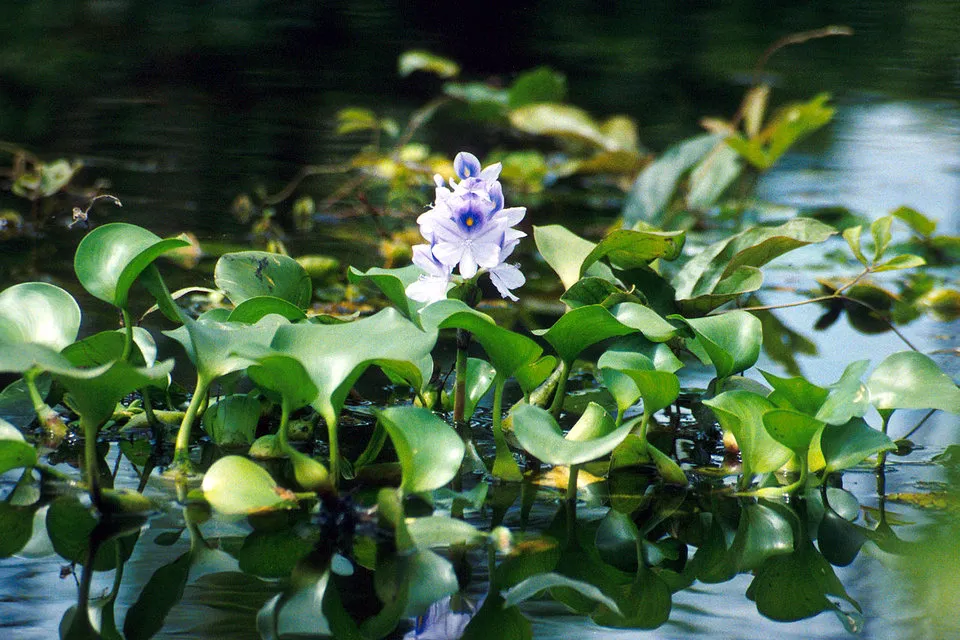
Carolina azolla (Azolla caroliniana)
Carolina azolla (Azolla caroliniana) is often grown in fish tanks. You can also use them in small water reservoirs, especially knowing that it’s durable and requires little attention. Carolina azolla has many advantages:
- it tends to grow fast,
- it helps to reduce algae in the pond,
- it can serve as food for fish,
- it can survive winter.
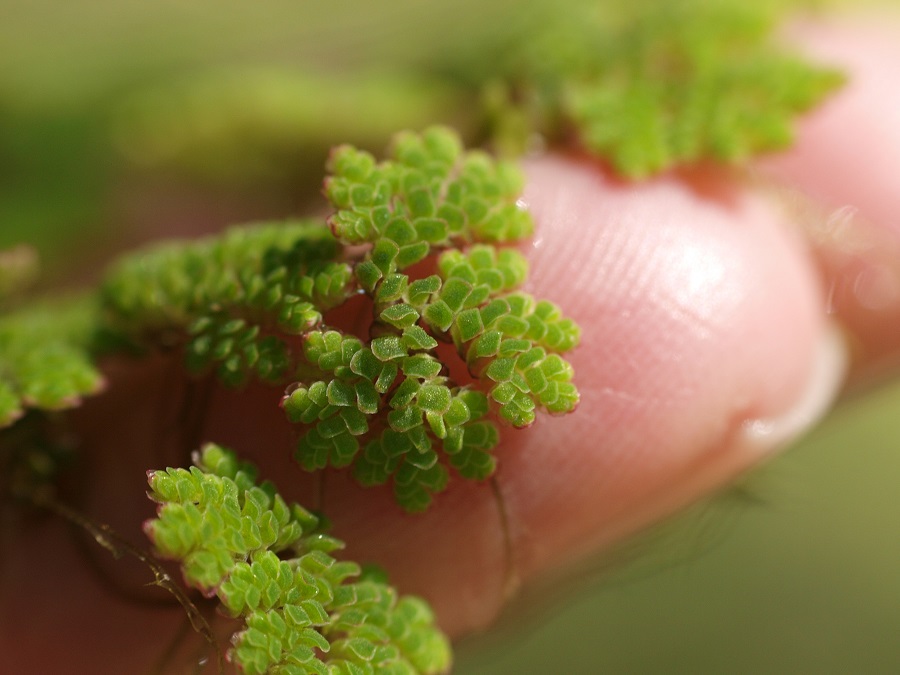
Spongeplant (Limnobium spongia)
Spongeplant (Limnobium spongia) is native to North America. It likes full sunlight, although it thrives in half-shade as well. Its main purpose is preventing algae from appearing in the pond. The species is resistant to low temperatures, so you don’t have to worry about its durability.
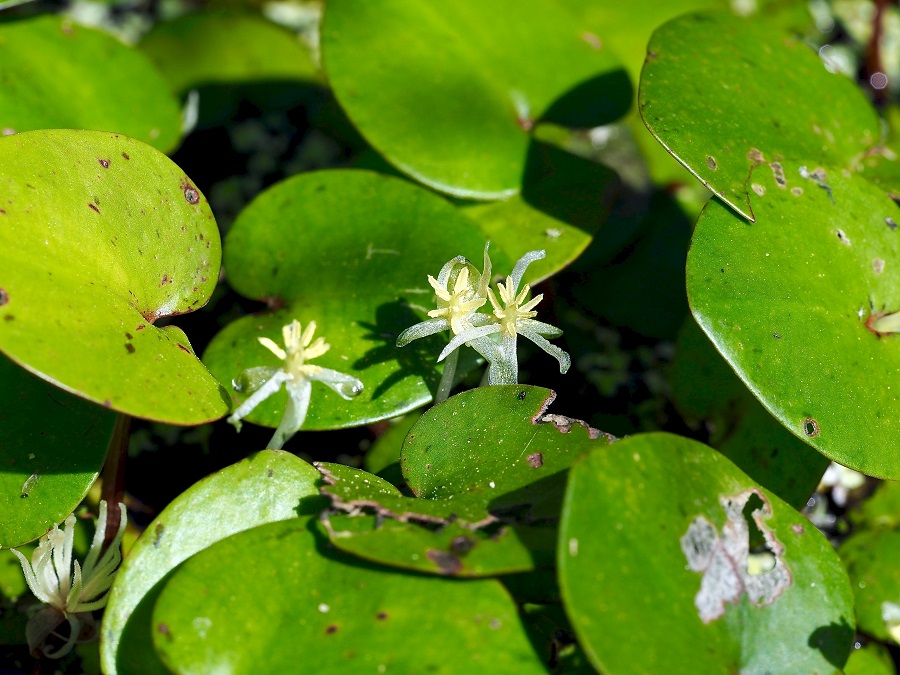
Eared watermoss (Salvinia auriculata)
Eared watermoss (Salvinia auriculata) belongs to the family of ferns which can grow in water reservoirs. The species doesn’t grow tall – singular plants don’t exceed the size of 10-11 cm. The structure of the leaves is the most interesting feature of this pond plant. They are covered with tiny hair. They protect the plant from retaining water. Water drops simply fall off, and the leaves remain dry all the time. Eared watermoss is valued for its high resistance. It can survive even very low temperatures.

Coontail (Ceratophyllum demersum)
Coontail (Ceratophyllum demersum) is another plant popular among fish keepers. It can also grow in external water ponds. It spreads quickly and makes a perfect shelter for fish, if they live in the reservoir. What’s more, it removes harmful substances:
- nitrogen,
- ammonia.
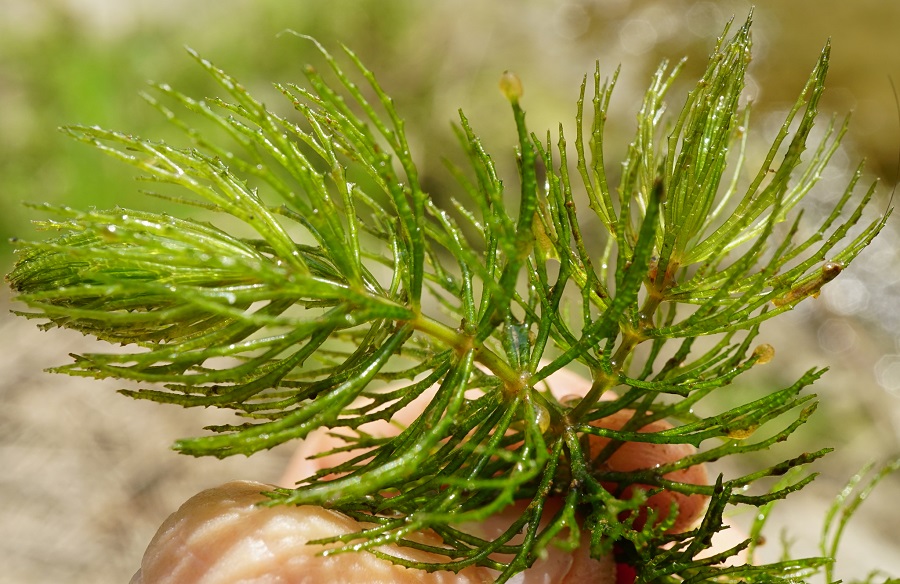
Watercress (Nasturtium officinale W. T. Aiton)
Watercress (Nasturtium officinale W. T. Aiton) is a plant originating in Asia. It quickly gained popularity nearly in the entire world. Interestingly enough, the species is edible and has health benefits, although few people make use of them.
Watercress grows maximally 90 cm tall and is an annual. It prefers growing in shade, where it can develop better. The location affects the taste of the plant. It’s important if you’re planning to harvest it for consumption.
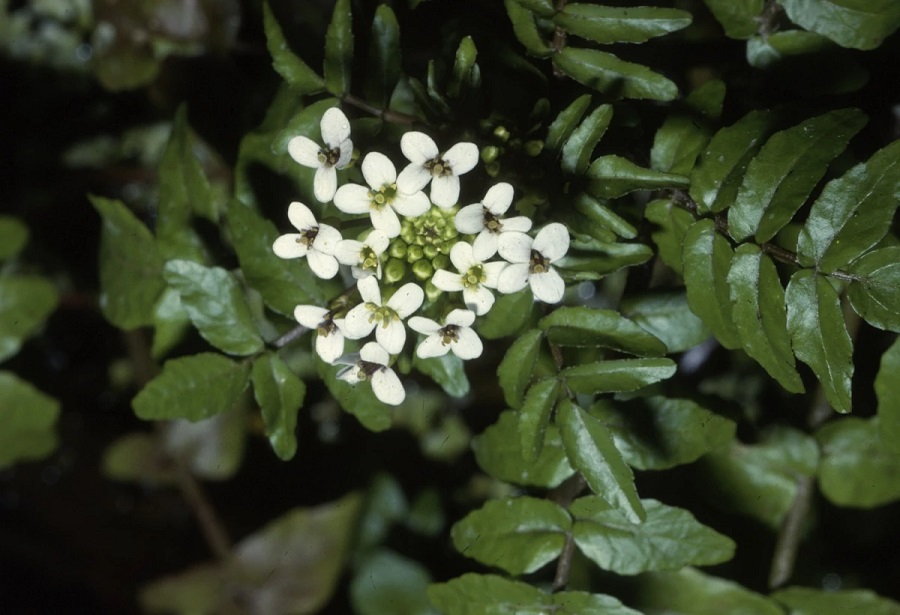
Small pond plants
Small ponds plants typically don’t exceed 4-50 cm of height. Of course, there are singular, higher plant species you can plant in a small pond. But make sure not to use too many of them. Otherwise, you might disrupt the aesthetics of the reservoir. Below, you can find the most popular small pond plants. They are typically planted in home yards.
Canadian waterweed (Elodea canadensis)
Canadian waterweed (Elodea canadensis) is one of the fastest growing aquarium plants. There are a few slightly different types of this plant. Interestingly enough, they can be purchased not only in gardening stores, but also in pet shops.
Canadian waterweed has many heavily branched, although short stems. It can perfectly endure any year-round conditions. As an additional advantage, it oxygenates and filters water.
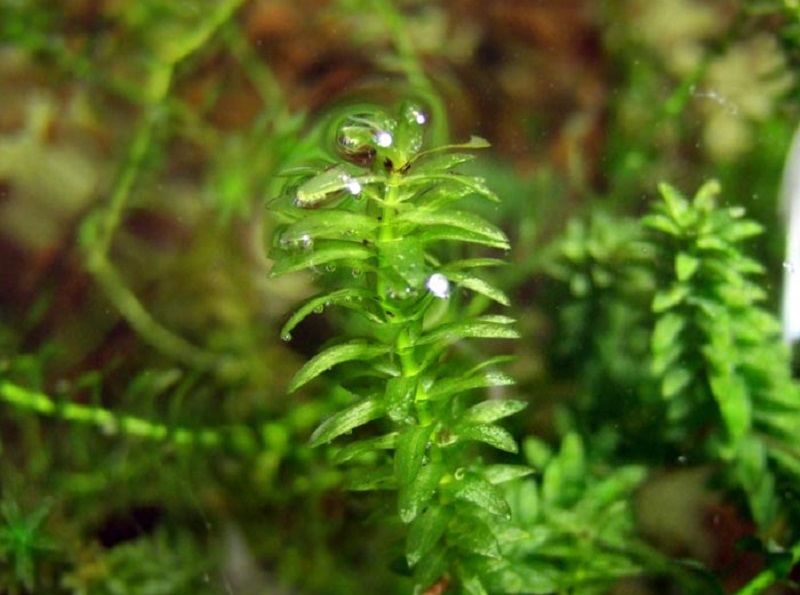
Water violet (Hottonia palustris)
Water violets (Hottonia palustris) are easy to maintain aquatic plants. They can grow in any location – in sun and shade. The plant has characteristic small and bushy flowers. They make a beautiful water pond decoration, although they appear only between May and June.
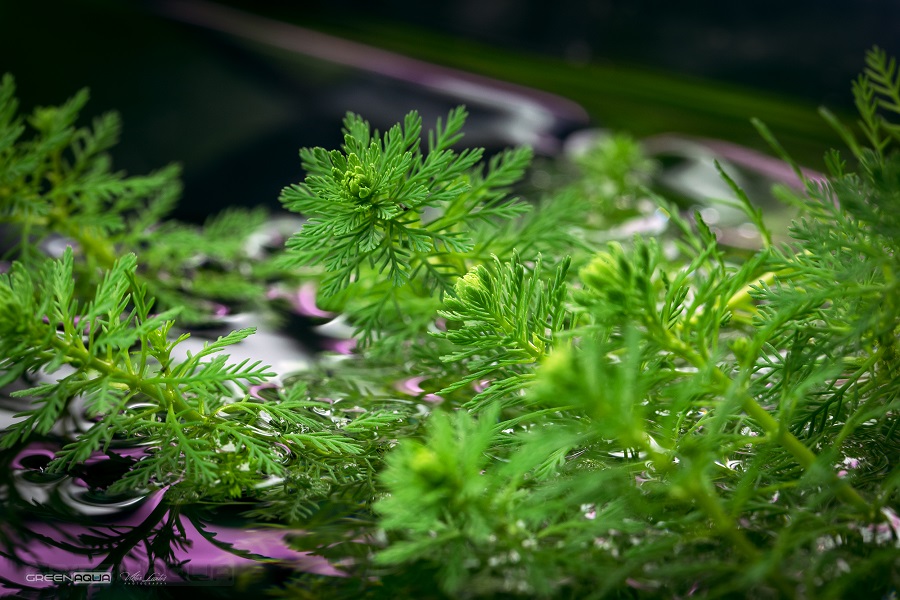
Common hedgehyssop (Gratiola officinalis)
Hedgehyssop (Gratiola officinalis) is a small plant, growing no taller than 50-60 cm. It likes sunny places, where it can fully develop. Interestingly enough, its leaves and roots are often used in herbal medicine. It is a diuretic and a laxative. But don’t attempt to use the plant growing near a pond on your own. In the wrong proportions, it might pose a danger to one’s health.

Bogbean (Menyanthes trifoliata)
Bogbean (Menyanthes trifoliata) is a small plant which grows no taller than 30 centimeters. It has interesting leaves and flowers that decorate reservoirs. This species is resistant to low temperatures, therefore, it can withstand cold winters. Note that the leaves die in winter. They should be removed to prevent any bacteria from developing.
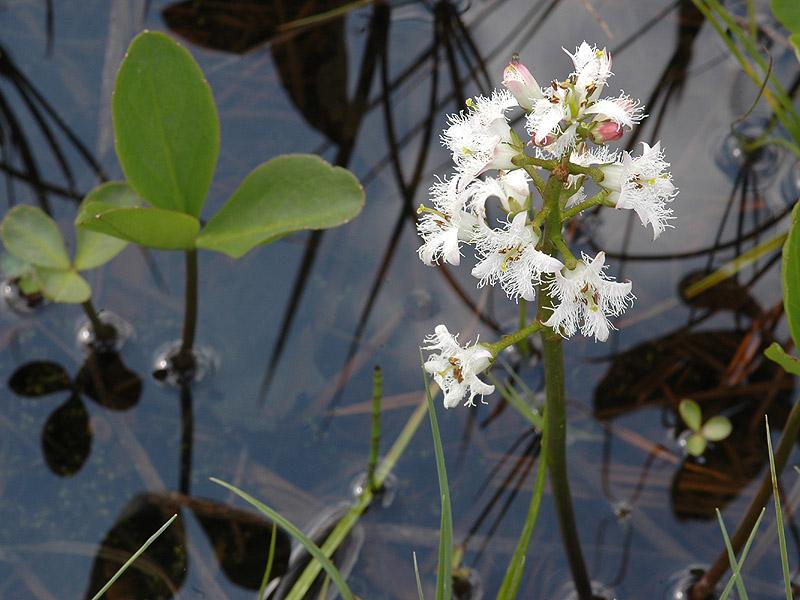
Great yellowcress (Rorippa amphibia)
Great yellowcress (Rorippa amphibia) is a perfect perennial for ponds. It can grow up to 100 cm tall, although typically it’s shorter. It’s commonly used in medicine because of its healing properties. Additionally, it has characteristic long and jagged leaves. Tiny yellow flowers are the decorative element.
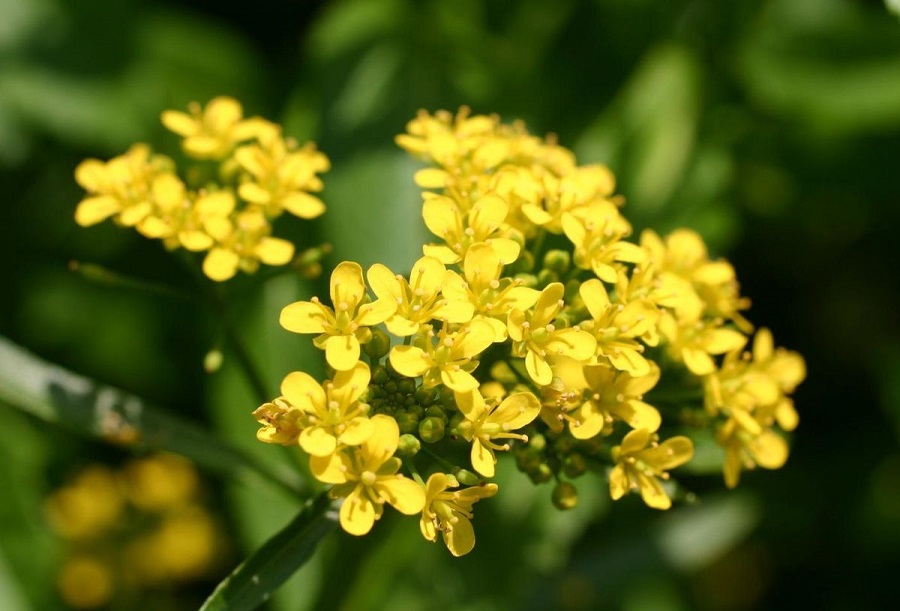
Swamp stonecrop (Crassula Helmsii Recurva)
Swamp stonecrop (Crassula Helmsii Recurva) is a very short pond plant. It usually doesn’t exceed 15-20 cm. Thanks to this, it’s perfect for small reservoirs. It has a very lively green color, loves sunny locations and produces oxygen in water.

What are the best plants for a large pond?
If your garden is large, you can decide to create an impressive reservoir. In this case, tall pond plants look fantastic. Are you wondering which species to pick? Find the most popular tall aquatic plants below.
Brooklime (Veronica beccabunga)
Brooklime (Veronica beccabunga) is an exceptionally resistant aquatic plant. It spreads quickly, especially if planted in the bog zone. It has characteristic jagged leaves which grow out of red stems. This pond plant blooms at the end of spring – that’s when small blue-and-purple flowers appear.
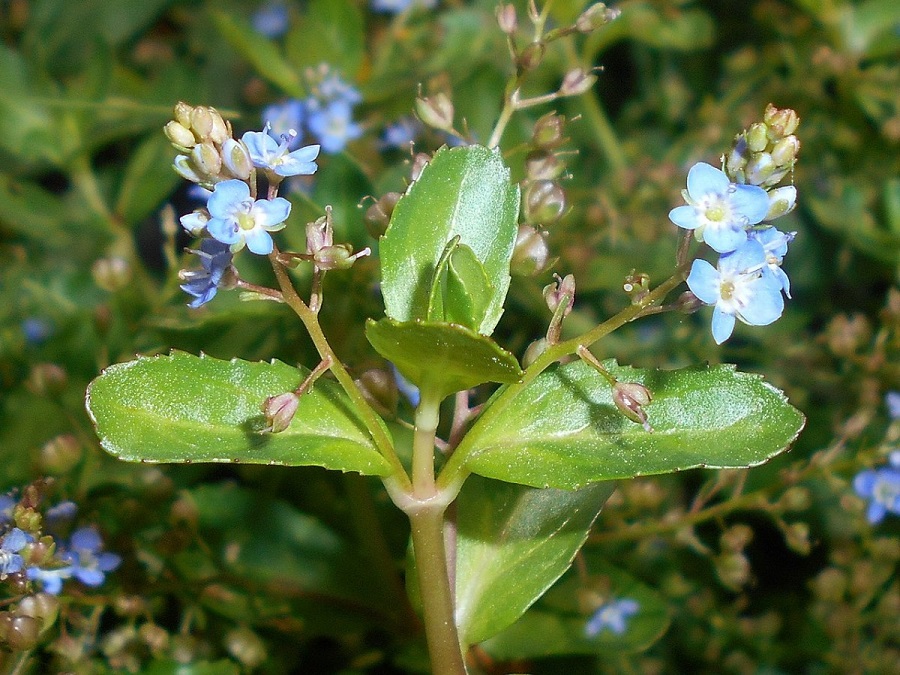
Simplestem bur-reed (Sparganium erectum)
Simplestem bur-reed (Sparganium erectum), depending on the variety and the place of growth, can reach even 150 cm of height. Compared to other pond plant, simplestem is quite demanding. It prefers fertile soils rich in nutrients. It develops peculiar ball-shaped flowers with many stamens.

Soft rush (Juncus effusus)
Soft rush (Juncus effusus) is a popular perennial which grows over 1 meter tall. It’s easy to take care of and doessn’t require much attention. Additionally, it’s resistant to very low temperatures and is not vulnerable to diseases and pests. Soft rush has a long blooming period – typically from June to August. All you have to do is plant it in a sunny or half-shaded location.
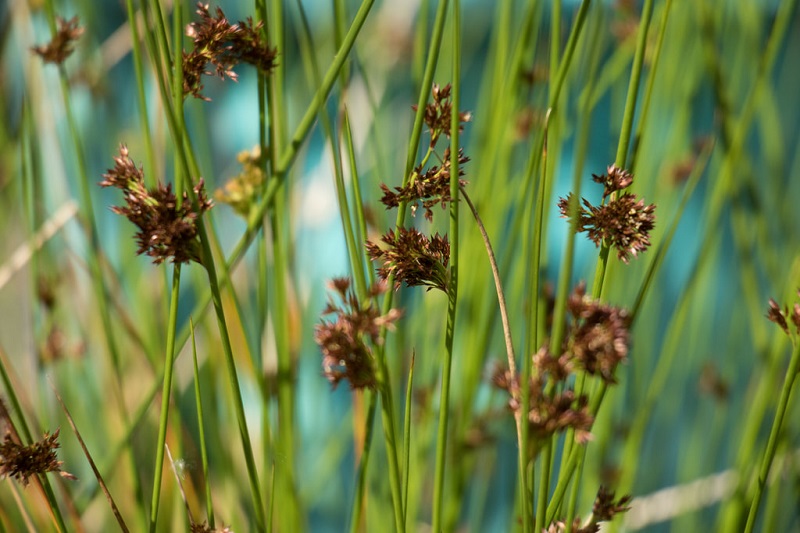
Meadowsweet (Filipendula ulmaria)
Meadowsweet (Filipendula ulmaria) is a bog plant which occurs in the natural environment. It can be easily cultivated as a pond plant. Half-shaded spot is the best location for this species. Make sure to fertilize and deacidify the soil before planting meadowsweet.
Meadowsweet grows up to 100 cm tall. It has characteristic pink flowers. They are a perfect decoration for leafy species growing in the pond.

Mare’s tail (Hippuris vulgaris)
Mare’s tail (Hippuris vulgaris) is a very characteristic water pond plant. Its stems are of a medium length – but they are distinct for their stiff structure and a lot of tiny leaves growing on the sides. The plant blooms – in good conditions from May until August. The flowers are small and green, so not many people notice them.
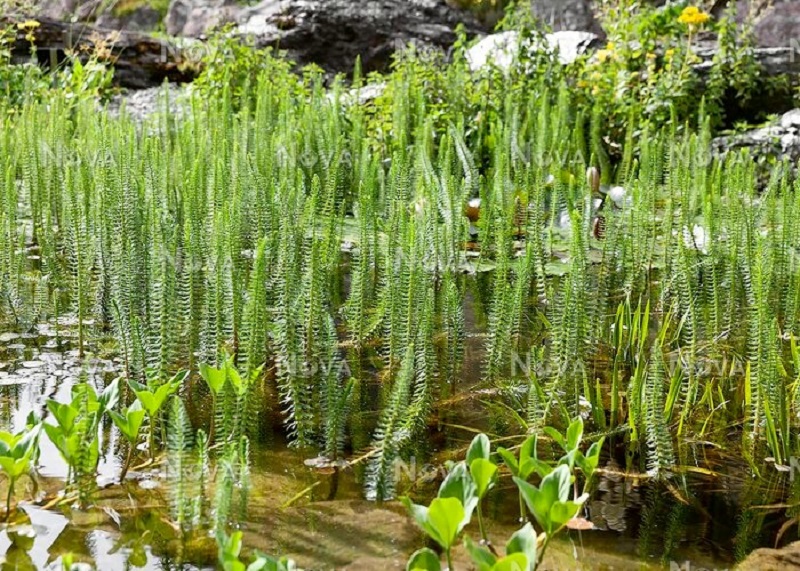
Floating plants for ponds
Floating pond plants are unique. They are worth having even if you decided to plant other species in the marsh zone. They enrich the reservoir’s aesthetics, especially during their blooming season. Take a look at the most popular species cultivated in gardens.
Common frogbit (Hydrocharis)
Common frogbit (Hydrocharis) is a unique floating pond plant. It develops beautiful white flowers with yellow centers. It blooms for quite a long time, as the flowers appear in May and last until August, if the weather is good. They have a characteristic beautiful smell – it’s strong enough to notice it when walking nearby the pond. Common frogbit is perfect for small ponds with shallow waters.
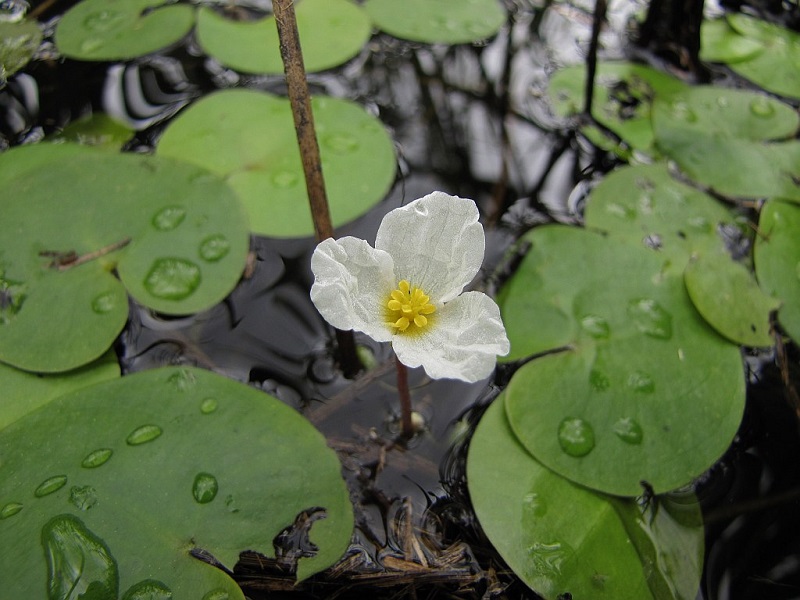
Longroot smartweed (Polygonum amphibium)
Longroot smartweed (Polygonum amphibium) is an interesting plant which can grow in two forms. It’s perfect on land, but it looks far better as a floating pond plant. That’s why it’s often picked for reservoirs.
Longroot smartweed has characteristic long and wide leaves. The flowers are noteworthy as well. They grow on stems sticking out of water and look like oval heads. They are white-and-pink. The plant blooms from April to September, depending on the weather.

Yellow floating heart (Nymphoides peltata)
Yellow floating heart (Nymphoides peltata) is often referred to as fringed water lily. The plant’s leaves are similar to lily leaves. But the flowers look different – they are yellow and have a different size and shape. Yellow floating heart loves fertile and muddy soils. It grows perfectly in shade.
Spadderdock (Nuphar lutea)
Spadderdock (Nuphar lutea) is a perennial which is often compared to yellow floating heart. The two plants are often confused. Spadderdock looks quite impressive – its leaves are oval, and it blooms in yellow. Make sure to be extra careful if you decide to grow this plant in your pond, as it’s poisonous.
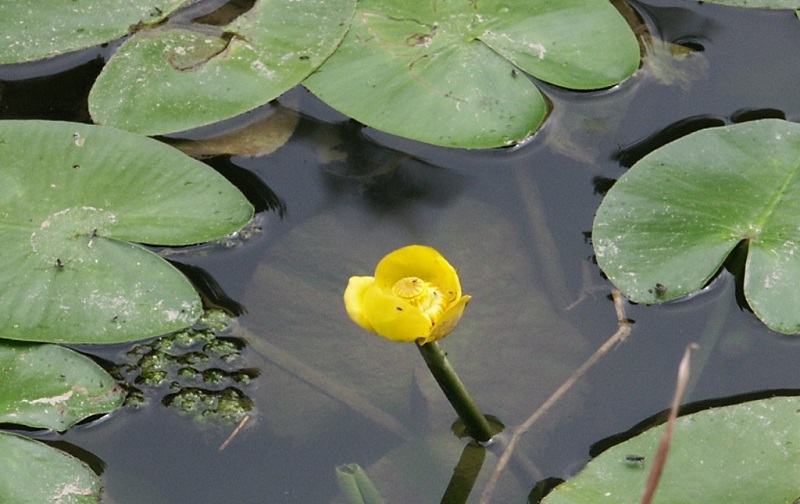
White water-crowfoot (Ranunculus aquatilis)
White water-crowfoot (Ranunculus aquatilis) is a characteristic plant which sprads quite heavily. It’s unique for its many small white flowers with yellow centers. They appear from May to August.
Water-crowfoot doesn’t grow tall – its typical maximum height is 50 cm. It’s a perfect small pond plant, especially considering it does’t need much attention.
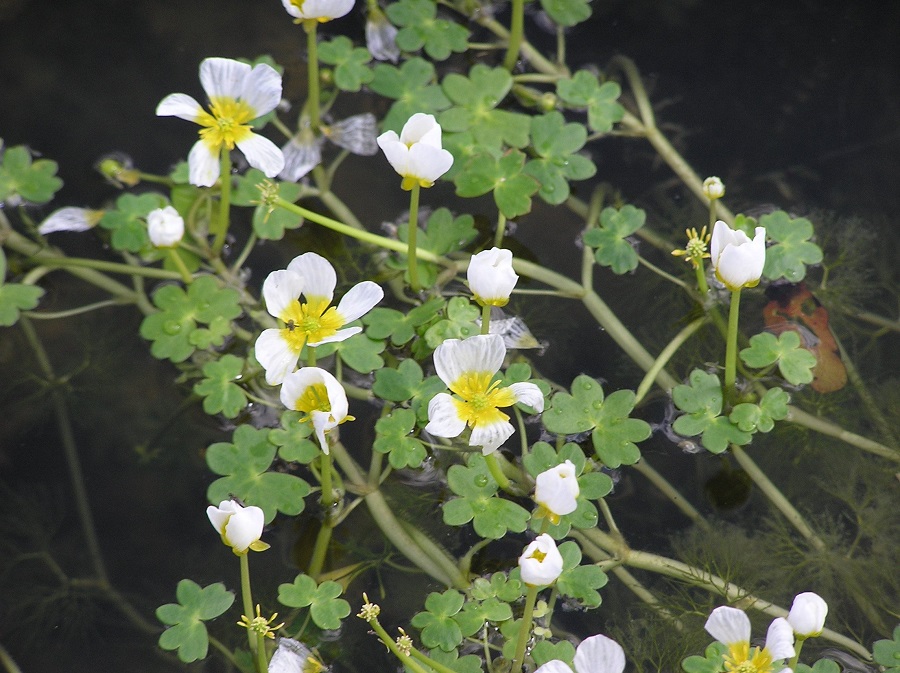
When should you decide on artificial pond plants?
Although pond plants aren’t difficult to grow, they still need a minimal attention from the owner. Sometimes, those who decide to create a water pond in their gardens don’t have enough time to take care of it. If it’s your case, you can invest in an automatic water-cleaning system and artificial pond plants.
📍 Where to buy pond plants?
You can purchase pond plants in gardening stores – online and physical. Additionally, pet stores often offer such plants for fish tanks. You can also search for aquatic plants on online auction websites.
📍 What are the best small pond plants?
Short species are the best plants you can put in your small pond. Plants which grow no taller than 50 centimeters are the best option. Before making a decision, check how fast the plant spreads underwater.
📍 How to plant pond plants?
Planting pond plants is nothing difficult. They involve standard actions required when planting any other plant. You can ask for some tips when purchasing a particular plant.
📍 What pond plants remove algae?
Algae are one of the biggest issue occuring in ponds. Fortunately, you can tackle it by planting certain pond plants. Longroot smartweed, Canadian waterweed and curled pondweed can help. You can also pick species such as cladophora ball, hornwort and mare's-tail. Each of the mentioned pond plants helps with the problem of algae.
Featured articles

